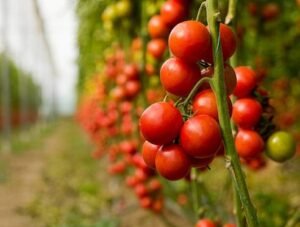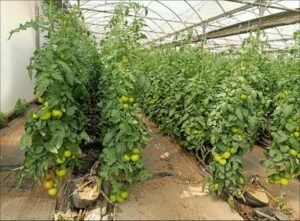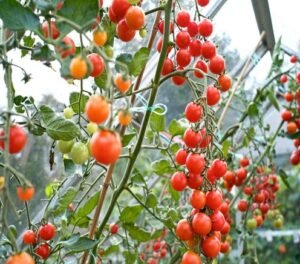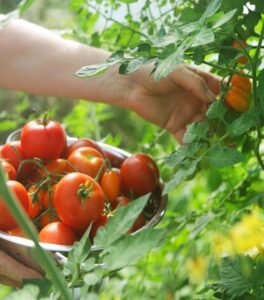Tomato Planting, Care & Harvesting in Polyhouse
Tomato Cultivation in a Polyhouse
Tomato is a herbaceous plant that grows to 1-3 m in height and has a weak woody stem. It belongs to the Solanaceae Family and its scientific name is Solanum lycopersicum.
The flowers of the tomato plant are yellow in colour and the fruits are available in different varieties with different sizes like Cherry tomatoes and beefsteak tomatoes.

Fast Growing Vegetables Tips & Tricks.
Tomatoes are rich in Vitamin C and phytochemical lycopene and are generally eaten raw in salads and are even cooked as a vegetable. It is also used as an important ingredient in various dishes and is pickled as well.
China, Japan and the USA are one of the leading countries that have a large space of land under polyhouse Farming for horticulture crops in the world and they have developed several tomato varieties through Polyhouse breeding.
The leading producers of tomato in India are Uttar Pradesh, Karnataka, Maharashtra, Haryana, Punjab and Bihar with a total of 1000 hectares of land.
Tomatoes are cultivated in a polyhouse from seed to earn maximum profits and In this article we will learn about Farming Tomatoes in a Polyhouse.
How to do cucumber farming in Polyhouse?
Importance of a Polyhouse production & Reasons for preferring Protected Cultivation of Tomatoes
Polyhouse tomato production offers to produce tomatoes even during the low supply and increases the length of time for which the tomatoes are available in a market and these tomatoes are even sold at higher prices than the field tomatoes.

The polyhouse system offers profitable opportunities in the spring season (before the field tomatoes are harvested) and even when the field tomato gets depleted. During the February and March month, the plant sets more fruit per plant and the heating cost is also less as the light intensity and duration increases on the outside which increases the temperature inside so it becomes less costly and it also provides ventilation and humidity control. This increases the yield making the spring production more profitable.
Farmers adopt commercial protected cultivation of high value vegetables and flowers and the reason for protected cultivation of tomatoes are:
- It produces better quality crops.
- The productivity is higher.
- The plants can be raised in a nursery and hardening of plants can be done.
- It provides better insect and disease control and the use of pesticides is also very less.
- It can also be cultivated during off seasons and the resources are used efficiently.
High yield onion farming for the beginners.
Varieties of Tomato suitable for a Polyhouse
The success of a Polyhouse tomato cultivation is based on the selection of a suitable cultivar and the important characteristics related to the cultivars include:
- It should have high yielding
- It should not crack
- It should be disease resistant
- It should set a more number of fruits
- It should be resistant to Green shoulders
- It should have a higher shelf life and total soluble sugars.
The hybrid varieties that can grow at a height of 15 feet and above and can utilise the vertical space in the Polyhouse and have a potential of yielding 170 tons per hectare and more from a group of six months duration are considered best for a Polyhouse cultivation.
The indeterminate tomato varieties are suitable for polyhouse cultivation. Avtar, Indam hybrid, All Rounder, Arka Meghali and Arka Surabhi are some of the suitable varieties for tomato cultivation in a Polyhouse.
How Automated Irrigation System Work?
Cultivation of Tomatoes in a Polyhouse
Tomato is a high value vegetable crop which can be grown during the main season and also in the off season under polyhouse Farming. It requires only a partially ventilated low cost polyhouse with Polythene and Agro shade net.
The polyhouse can be designed in such a way that the farmers can produce high value crops in the off season where the prices of the farm produce are at their highest and in this way you can earn higher incomes and higher return on the high initial investment.
In the polyhouse, you can control the light, temperature, humidity, water for irrigation and therefore you can generate all the crops that fetch high prices in local and regional markets.
You can even generate pesticide free produce or even organic produce which will fetch you a higher price due to their high nutritional value, better taste and freshness.
Papaya farming method for beginners.
Climatic Requirements
Tomato generally prefers a moderate temperature and it could grow well in the temperature range of 25 to 30 degree Celsius. Low temperature range and high humidity can cause severe infestation of diseases.
Soil requirements
Tomato crops can be grown in a wide range of soil ranging from light textured sandy soil or sandy loam soil to heavy clay soil but the most important thing is that the soil must be rich in nutrients and organic matter with a pH level of 6 to 7 for proper growth. The soil requires high organic matter content for higher production and quality.
Intercultural Operations
Tomato is a shallow rooted crop and the roots are restricted within 15 to 20 cm of soil, so it requires light earthing after 30 to 45 days of planting.
Mulching of Tomato plants in a Polyhouse
In general, straw mulch is used for mulching purposes. It is applied to the soil when the tomatoes are about 2 feet high. The mulch helps in reducing the evaporation of water from the soil and prevents the compaction of the surface.
Plastic mulches are recommended to control weeds, conserve moisture, reduce humidity and develop light conditions so as to avoid contact to soil and also for preventing diseases.
Best Farming Method For Green Pea.
Weed Control
During the first 4 weeks, there is a requirement of light hoeing so as to remove the weeds from the field. The surface soil should be made loose by hand hoeing when it gets dry enough after every irrigation and all the weeds should be removed during this process.
Straw, Black polythene and other materials are helpful as mulching materials for moisture conservation and controlling the seeds of weeds and various diseases as well.
Some farmers use Black plastic mulch for controlling the weeds particularly when the crop is grown under plastic raw tunnels. Some herbicides are also recommended for using on tomatoes but it doesn’t give complete control on the annual weeds therefore supplemental cultivation is necessary and these herbicides often burn the weeds from between the rows of plastic mulch.
Irrigation Requirements
It requires good quality of water at 10 days interval and the plants must be provided with a strong stake after one month of plantation.
Drip Irrigation System For The Beginners.
The tomato plant requires proper irrigation at proper timing. In spring summer, it should be irrigated at an interval of 4 to 6 days depending upon the growth and the best Irrigation system is the Drip irrigation where the water is supplied in a measured quantity and it also optimises the plant nutrition without fluctuating the nutrient level in the root zone.

It minimizes the loss by fixation or leaching in the soil and therefore it is economically effective in producing high-quality and improved yield of plants. It also helps in the conservation of water.
Seed Treatment of Tomatoes
The seeds are applied with Trichoderma @ 5 to 10 g per kg seed or Carbendazim @ 2g per kg seed, for avoiding damping off disease. These treated tomato seeds are then dried in shade for 30 minutes and sown sparsely along the lines with a depth of half cm which is then covered by the layer of topsoil.
Raising Tomato Seedlings for Polyhouse Farming
The seedlings are grown in raised beds of 60-100 cm width and of convenient length, before one month of transplanting them. The nursery bed is covered with white transparent polythene sheet for one month during the hot summer months for soil solarization and for killing disease-causing organisms like fungus, nematodes, bacteria as well as insects and seeds of weeds.
Fertigation with Drip Irrigation System.
For preparing the nursery beds, Neem cake, Castor cake, Castor leaf, Pongamia leaf and Calotropis leaf are incorporated at 400 g per m² for protecting them against Nematodes. After sowing the seeds, Green Leaves are used for mulching and are then irrigated with a rose-can on a daily basis during the morning time.
The mulch is removed immediately as soon as the seeds germinate and irrigation is also stopped for one week before transplanting and then irrigated just one day before transplanting. Cover the bed with a fine nylon net for escaping the damages by virus transmitting insects.
Fertigation of Tomato Plants
N:P:K @ 200:200:200 kg per ha is applied through Fertigation for entire crop growth by using water soluble fertilisers.
The micronutrient formulation should be sprayed @ 3g per litre, 2 to 3 times every 30 days, after 60 days of transplanting. The tomato crop is also fertigated 2-3 times with Calcium nitrate once after every 15 days.
The N:P:K fertilisers are applied in 10 equal splits at an interval of 10 days through the Drip irrigation system.
Brinjal Farming methods for beginners.
Pests and diseases of tomato plants
Tomato plants are susceptible to several pests and diseases. Some of them are Bacterial wilt, Early blight, Mosaic virus, Fusarium wilt, Nematodes and Tomato hornworms. Many of them can be controlled with crop rotation, using fungicides and pesticides and using the resistant varieties of tomato.
Some other diseases like Damping off, Septoria leaf spot, Early blight and Late blight are controlled by hot water treatment of seeds and spraying proper fungicides. Potato fields are recommended to not plant near the tomato fields.
Protected Farming Guide For Beginners.
Harvesting Tomatoes in Polyhouse
The tomatoes can be harvested after 90 days of transplanting. The total crop period is 8 to 9 month after planting and harvesting is done on a daily basis or on alternate days, depending on the market distance and demand.

For marketing them to a long distance, the tomato fruits are picked up when they are at matured green or breaker stage. For the processing purpose, the fully matured red ripened tomato fruits are harvested for optimising the quality parameters. The ideal storage conditions for tomatoes are 12 °C temperature and 86 to 90% relative humidity.
Yield of Tomatoes
On an average, Tomato plants give a yield of 6-8 kg per m² under proper care. The average yield is 3-4 kg per plant with a fruit weight of 80-90g.
Conclusion
The main aim of Polyhouse cultivation is to enhance the socio economic characteristics of the small and marginal farmers and to generate a higher income, employment and a decent standard of living and also to promote off season cultivation. The protected cultivation has a higher productivity and it also improves the quality of the crop and gives profitable income to the farmers.




